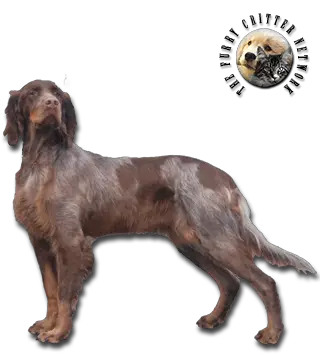Breed Standard
Head: Strong. Broad, rounded skull. Pronounced occipital peak. Sloping stop. Broad, long nosebridge. Lips not too pendulous. Brown nose.
Ears: Set on fairly low, framing the head well, covered with silky, wavy hair.
Eyes: Dark amber.
Body: Athletic. Well-muscled neck. Deep, fairly broad chest let down to elbow. Loin very straight, broad, and thick. Hips slightly lower than withers. Flat flanks. Moderate tuck-up. Croup rounded, very slightly sloping.
Tail: Forming two loose curves inward and outward, not too long. Covered with silky hair.
Hair: Medium in length, thick, not very silky. Fine on the head. Slightly wavy on the body.
Coat: Grey, spotted, with brown blotches on various parts of the body and the base of the tail, usually with tan markings on the head and legs.
Size: 55 to 60 cm (22-23.5 in).
Weight: 20 to 25 kg (44-55 lb).
History
The Picardy Spaniel has long been known in France's Somme Valley. Like the French Spaniel, he is descended from the old, longhaired Chien d'Oysel (setter) used to point game birds in the Middle Ages. Some believe the Picardy Spaniel is a cousin to the setters. After a decline in popularity in the late nineteenth century, the breed was shown in Paris in 1904, renewing the interest of hunters. The first standard was written in 1908. The Picardy Spaniel has never been common outside his native region.
Behavior
The Picardy Spaniel is a docile breed of dog and is fond of playing with children and bonds well with their master. It is described as having a gentle sociable nature, possessing a good character with a laid-back attitude, and being relatively easy to train. In France, the breed is used for hunting in wooded areas for pheasants, and in swamps for snipes. However it can also be used for hunting ducks, hares and rabbits. The breed excels at hunting in marshes and will not hesitate to jump into water. It can also adequately serve as a retriever should it be required.
This hardy dog with great endurance and a remarkable nose works well on any kind of terrain, especially swampland. He is a persistent hunter, a perfect pointer, and an excellent retriever. He works well on duck and woodcock, as well as rabbit and hare. Merry, gentle, friendly, and good-natured, he makes a delightful pet. The dog is content with a small amount of space and could suit life in the city, but also loves open spaces.
Function
Hunting Dog, Companion Dog.
Health
The Picardy Spaniel has no known hereditary health problems, and has an average lifespan of 14 years. However being a hunting spaniel, the breed is prone to ear infections. These infections are common among dogs with pendulous ears, including Basset Hounds and other breeds of spaniel. Overfeeding a Picardy Spaniel may lead to overweight.






